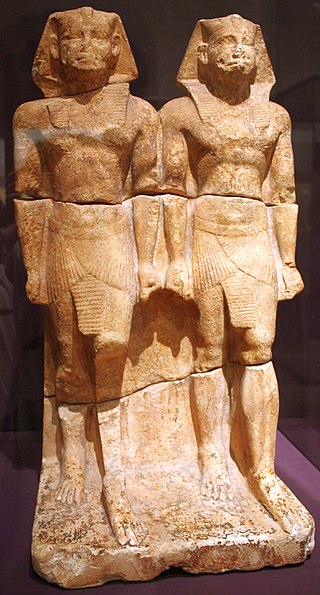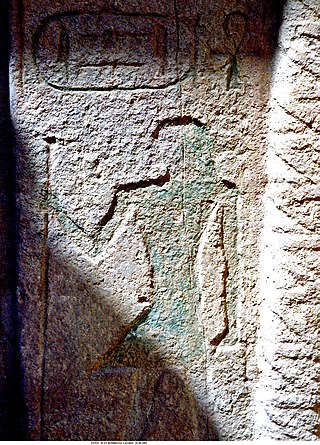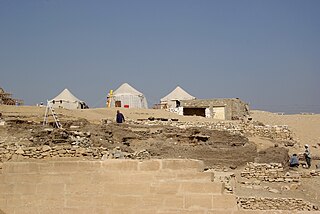Related Research Articles

Memphis, or Men-nefer, was the ancient capital of Inebu-hedj, the first nome of Lower Egypt that was known as mḥw ("North"). Its ruins are located in the vicinity of the present-day village of Mit Rahina, in markaz (county) Badrashin, Giza, Egypt. This modern name is probably derived from the late Ancient Egyptian name for Memphis mjt-rhnt meaning "Road of the Ram-Headed Sphinxes".

Menkauhor Kaiu was an Ancient Egyptian pharaoh of the Old Kingdom period. He was the seventh ruler of the Fifth Dynasty at the end of the 25th century BC or early in the 24th century BC.

Nyuserre Ini was an Ancient Egyptian pharaoh, the sixth ruler of the Fifth Dynasty during the Old Kingdom period. He is credited with a reign of 24 to 35 years depending on the scholar, and likely lived in the second half of the 25th century BCE. Nyuserre was the younger son of Neferirkare Kakai and queen Khentkaus II, and the brother of the short-lived king Neferefre. He may have succeeded his brother directly, as indicated by much later historical sources. Alternatively, Shepseskare may have reigned between the two as advocated by Miroslav Verner, albeit only for a few weeks or months at the most. The relation of Shepseskare with Neferefre and Nyuserre remains highly uncertain. Nyuserre was in turn succeeded by Menkauhor Kaiu, who could have been his nephew and a son of Neferefre.

Rahotep was a prince in ancient Egypt during the 4th Dynasty. He was probably a son of Pharaoh Sneferu and his first wife, although Zahi Hawass suggests his father was Huni.

Khuit I was an ancient Egyptian queen who has been tentatively dated by association to have lived during the 5th Dynasty of the Old Kingdom.

Isesi-ankh was an ancient Egyptian high official during the second half of the Fifth Dynasty, in the late 25th to mid 24th century BC. His name means "Isesi lives". He may have been a son of pharaoh Djedkare Isesi and queen Meresankh IV, although this is debated. Isesi-ankh probably lived during the reign of Djedkare Isesi and that of his successor Unas. He was buried in a mastaba tomb in north Saqqara, now ruined.

The High Priest of Ptah was sometimes referred to as "the Greatest of the Directors of Craftsmanship". This title refers to Ptah as the patron god of the craftsmen.
Sabu called Ibebi was a High Priest of Ptah during the reigns of Kings Unas and Teti.
Sabu also called Tjety was the High Priest of Ptah in the Sixth Dynasty of Ancient Egypt, around 2300 BC. Sabu is mainly known from the remains of his mastaba in Saqqara (E.3). The inscriptions on the fragment of a false door were copied in the 19th century and present part of a biography. The fragments are today in the Egyptian Museum in Cairo. Sabu bears several titles including: Greatest of the Directors of the Craftsmen in the two houses, chief lector priest, sole friend and count.
Ranefer or Ranofer was a High Priest of Ptah, who lived at the beginning of the Fifth Dynasty of Ancient Egypt. His name means "Ra is beautiful". His main title was "greatest of the directors of craftsmen belonging to the day of festival". This is a variation of the title normally assigned to the high priest of Ptah.

Akhethetep was a high dignitary of ancient Egypt who lived during the Fifth Dynasty around 2400 BC. Akhethotep and his son Ptahhotep Tjefi were senior court officials during the rule of Djedkare and of Unas (Wenis), towards the end of the 5th Dynasty. Akhethetep's titles included that of a vizier, making him to the highest official at the royal court, only second to the king. He was also overseer of the treasuries, overseer of the scribes of the king's documents and overseer of the granaries. Akhethetep was the son of Ptahhotep. His father was vizier too.

The Mastaba of Hesy-re is an ancient Egyptian tomb complex in the great necropolis of Saqqara in Egypt. It is the final resting place of the high official Hesy-re, who served in office during the Third Dynasty under King Djoser (Netjerikhet). His large mastaba is renowned for its well-preserved wall paintings and relief panels made from imported Lebanese cedar, which are today considered masterpieces of Old Kingdom wood carving. The mastaba itself is the earliest example of a painted tomb from the Old Kingdom and the only known example from the Third Dynasty. The tomb was excavated by the Egyptologists Auguste Mariette and James Edward Quibell.
Kaemtjenent was an ancient Egyptian official under pharaoh Djedkare Isesi in the late Fifth Dynasty, during the Old Kingdom period.
Ptahhotep Desher was an Ancient Egyptian official at the end of the Fifth Dynasty, most likely in office under kings Menkauhor Kaiu and Djedkare Isesi. His main function was that of a vizier. This was the most important office in Ancient Egypt, second only to the king. Ptahhotep also held other titles, such as overseer of the six great houses, overseer of the scribes of the royal documents and overseer of all royal works. These are all important functions, often held by a vizier.

Pehenuikai was an Ancient Egyptian official of the Fifth Dynasty. His main office was that of a vizier, making him to the most important man at the royal court, only second to the king. Beside being vizier, he was also holding many other important titles, such as Overseer of the treasuries, overseer of the scribes of the king's document, overseer of the double granary and overseer of all royal works of the king.
Kay was an Ancient Egyptian official living most likely in the Fifth Dynasty. He is mainly known for his mastaba in Saqqara North. Kay held a high number of important titles making him the most powerful person of his time, only second to the king. His main office was that of a vizier. Besides being vizier, he also held many other important titles, such as Overseer of the treasuries, Overseer of Upper Egypt, overseer of the scribes of the king's document, overseer of the six big houses and overseer of all royal works of the king. His mastaba in Saqqara was recorded by Gaston Maspero who assigned to it the number D 19. Kay bore 51 titles, making him the vizier with the highest number of titles. Kay was the first Egyptian official with the title of overseer of the six big houses. The office became one of the most important at the royal court in the later Fifth Dynasty and continued to be so during the subsequent Sixth Dynasty . The dating of Kay is uncertain. No biography is preserved in his tomb, and no king's name is mentioned. A date in the middle of the Fifth Dynasty has been proposed. Others prefer a date in the early Fifth Dynasty.
Washptah, with the second name Izi, was an ancient Egyptian official in the Fifth Dynasty under king Neferirkare Kakai. His most important title was that of a vizier, making him to the most important official at the royal court, only second to the king. Next to the office of the vizier he hold several other important positions, including overseer of the scribes of the king's document and overseer of all royal works.
Ptahhotep was an ancient Egyptian official of the Fifth Dynasty, most likely under king Djedkare Isesi. His most important office was that of a vizier, making him to the most important official at the royal court, only second to the king. Next to this important office he held further important titles, such as overseer of the treasuries, overseer of the scribes of the king's document, overseer of the six big houses and overseer of all royal works of the king.

Ptahshepses was an ancient Egyptian official at the end of the Fourth and the beginning of the Fifth Dynasty. His main title was that of a great one of the leaders of craftsmen, that in later periods is the main designation of the High Priest of Ptah.
Akhethetep was an ancient Egyptian official mainly known from his mastaba found at Saqqara. Not much is known about Akhethetep. On the reliefs of his mastaba he bears several titles, including overseer of the great house. This was an administrative title of rather unclear function. He had also several religious titles, including priest of Maat and priest of Hathor, lady of Dendera. He had also priestly functions at the funerary cult of different kings and was Priest of Nefer-Djedkare (this is the name of the pyramid of king Djedkare and priest at Nefersut-Unas.
References
- ↑ Jones 2000, p. 394, no. 1457.
- ↑ Jones 2000, p. 572, no. 2108.
- ↑ Jones 2000, p. 515, no. 1928.
- ↑ Mariette & Maspero 1889, pp. 156–157.